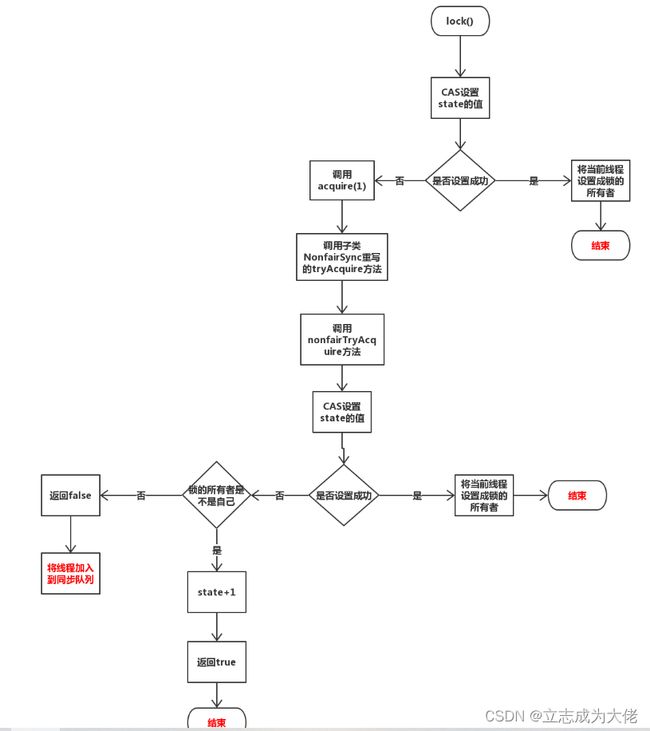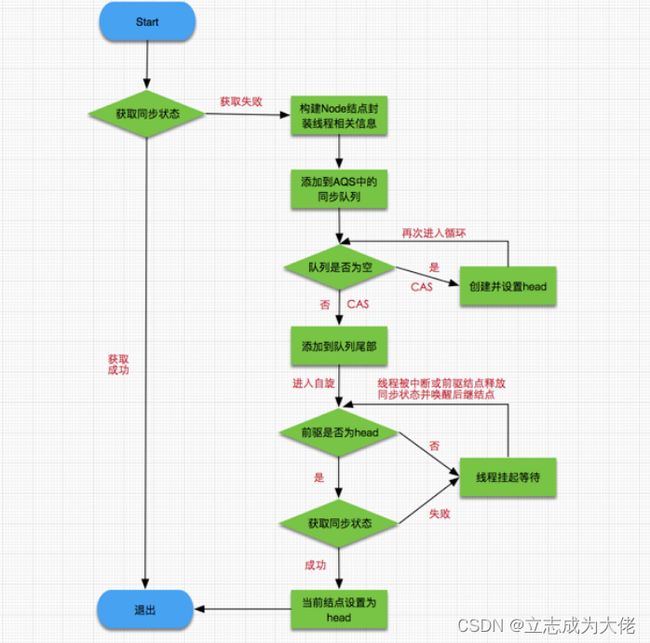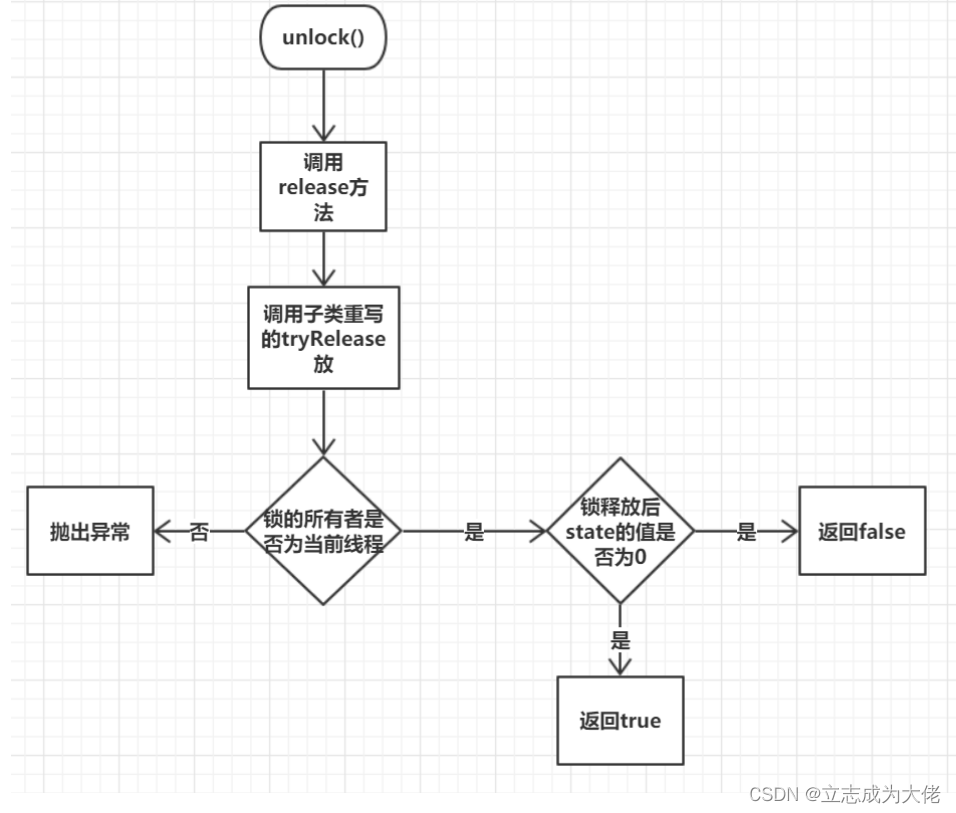面试题:ReentrantLock原理
ReentrantLock是基于AQS实现的一种可重入锁
ReentrantLock就是通过重写了AQS的tryAcquire和tryRelease方法实现的lock和unlock。

AbstractQueuedSynchronizer:抽象类,AQS框架核心类,其内部以虚拟队列的方式管理线程的锁获取与锁释放,其中获取锁(tryAcquire方法)和释放锁(tryRelease方法)并没有提供默认实现,需要子类重写这两个方法实现具体逻辑,目的是使开发人员可以自由定义获取锁以及释放锁的方式。
public abstract class AbstractQueuedSynchronizer
extends AbstractOwnableSynchronizer{
protected boolean tryAcquire(int arg) {
throw new UnsupportedOperationException();
}
protected boolean tryRelease(int arg) {
throw new UnsupportedOperationException();
}
protected int tryAcquireShared(int arg) {
throw new UnsupportedOperationException();
}
protected boolean tryReleaseShared(int arg) {
throw new UnsupportedOperationException();
}
protected boolean isHeldExclusively() {
throw new UnsupportedOperationException();
}
}
Sync:抽象类,是ReentrantLock的内部类,继承自AQS,实现了释放锁的操作(tryRelease()方法),并提供了lock抽象方法,由其子类实现。
NonfairSync:是ReentrantLock的内部类,继承自Sync,非公平锁的实现类。
FairSync:是ReentrantLock的内部类,继承自Sync,公平锁的实现类。
ReentrantLock的构造方法
public ReentrantLock() {
sync = new NonfairSync();
}
public ReentrantLock(boolean fair) {
sync = fair ? new FairSync() : new NonfairSync();
}
默认是非公平锁,也可以根据有参构造根据传入的参数来创建。
ReentrantLock的Lock()方法
public void lock() {
sync.lock();
}
去调用sync的lock方法,sync在ReentrantLock构造的时候已经被创建为公平/非公平。
对于非公平锁:
static final class NonfairSync extends Sync {
//加锁
final void lock() {
if (compareAndSetState(0, 1))
setExclusiveOwnerThread(Thread.currentThread());
else
acquire(1);
}
}
先对state进行cas操作,如果操作成功,表明获取锁成功,把当前线程设置为独占锁线程;如果操作失败,去执行acquire()方法
public final void acquire(int arg) {
//再次尝试获取同步状态
if (!tryAcquire(arg) &&
acquireQueued(addWaiter(Node.EXCLUSIVE), arg))
selfInterrupt();
}
protected final boolean tryAcquire(int acquires) {
return nonfairTryAcquire(acquires);
}
}
final boolean nonfairTryAcquire(int acquires) {
final Thread current = Thread.currentThread();
int c = getState();
if (c == 0) {
//执行CAS操作
if (compareAndSetState(0, acquires)) {
setExclusiveOwnerThread(current);
return true;
}
}
else if (current == getExclusiveOwnerThread()) {
int nextc = c + acquires;
if (nextc < 0) // overflow
throw new Error("Maximum lock count exceeded");
setState(nextc);
return true;
}
return false;
}
获取锁步骤
如果在tryAcquire()返回false,则表示当前线程获取锁失败,执行
acquireQueued(addWaiter(Node.EXCLUSIVE), arg)方法,将线程加入队列
public final void acquire(int arg) {
//再次尝试获取同步状态
if (!tryAcquire(arg) &&
acquireQueued(addWaiter(Node.EXCLUSIVE), arg))
selfInterrupt();
}
1.由当前线程构造一个节点。
2.若等待队列不为空时,则设置当前节点为队列尾节点。
3.若队列为空或者失败时,则重复尝试将该节点加入到队列成为尾节点。
private Node addWaiter(Node mode) {
Node node = new Node(Thread.currentThread(), mode); // 当前线程构造一个节点
if (pred != null) { // 设置当前节点尾队列的尾节点
node.prev = pred;
if (compareAndSetTail(pred, node)) {
pred.next = node;
return node;
}
}
enq(node); // 节点加入队列失败,则循环尝试加入队列,直到成功
return node;
}
// 队列为空或加入队列失败,则循环尝试加入队列,直到成功
private Node enq(final Node node) {
for (;;) {
Node t = tail;
if (t == null) { // 若队列为空,则当前节点设为头节点
if (compareAndSetHead(new Node()))
tail = head;
} else {
node.prev = t; // 若队列非空,则当前节点加入队列为尾节点
if (compareAndSetTail(t, node)) {
t.next = node;
return t;
}
}
}
}
这个方法使用一个死循环进行CAS操作,可以解决多线程并发问题。这里做了两件事,一是如果还没有初始同步队列则创建新结点并使用compareAndSetHead设置头结点,tail也指向head,二是队列已存在,则将新结点node添加到队尾。

来自:![]()
ReentrantLock的UnLock()方法
public void unlock() {
sync.release(1);
}
public final boolean release(int arg) {
//子类重写的tryRelease方法,需要等锁的state=0,即tryRelease返回true的时候,才会去唤醒其
//它线程进行尝试获取锁。
if (tryRelease(arg)) {
Node h = head;
if (h != null && h.waitStatus != 0)
unparkSuccessor(h);
return true;
}
return false;
}
protected final boolean tryRelease(int releases) {
//状态的state减去releases
int c = getState() - releases;
//判断锁的所有者是不是该线程
if (Thread.currentThread() != getExclusiveOwnerThread())
//如果所的所有者不是该线程 则抛出异常 也就是锁释放的前提是线程拥有这个锁,
throw new IllegalMonitorStateException();
boolean free = false;
//如果该线程释放锁之后 状态state=0,即锁没有重入,那么直接将将锁的所有者设置成null
//并且返回true,即代表可以唤醒其他线程去获取锁了。如果该线程释放锁之后state不等于0,
//那么代表锁重入了,返回false,代表锁还未正在释放,不用去唤醒其他线程。
if (c == 0) {
free = true;
setExclusiveOwnerThread(null);
}
setState(c);
return free;
}
公平锁加锁过程
ReentrantLock和Synchronized对比
1.两者都是可重入锁
“可重入锁”概念是:自己可以再次获取自己的内部锁。比如,一个线程获得了某个对象的锁,此时这个对象锁还没有释放,当其再次想要获取这个对象的锁时,还可以再获取的;如果不可锁重入的话,就会造成死锁;同一个线程每次获取锁,锁的计数器都自增1,所以要等到锁的计数器下降为0时,才能最终释放锁。
2. synchronized 依赖于 JVM,而 ReentrantLock 依赖于 API,synchronized 是依赖于 JVM 实现的。ReentrantLock 是 JDK 层面实现的
3.ReentrantLock 比 synchronized 增加了一些高级功能
ReentrantLock 提供了一种能够中断等待锁线程的机制,通过 lock.lockInterruptibly() 来实现这个机制,也就是说正在等待的线程可以选择放弃等待,改为处理其他事情;
ReentrantLock 可以指定是公平锁还是非公平,而 synchronized 只能是非公平锁。所谓的公平锁,就是先等待的线程最先获得锁;ReentrantLock 默认是非公平的,可以通过 ReentrantLock 类的 ReentrantLock(boolean fair) 构造方法来制定是否是公平的;
synchronized 关键字结合 wait() 和 notify()/notifyAll() 方法使用,可以实现等待/通知机制,ReentrantLock 类则需要借助于 Condition 接口与 newCondition() 方法。
4.synchronized 遇到异常自动抛出, ReentrantLock不能,因此unlock方法要放在finally里面
5. ReentrantLock可以通过trylock判断是否持有锁
6. ReentrantLock是显示锁,synchronized隐式锁

